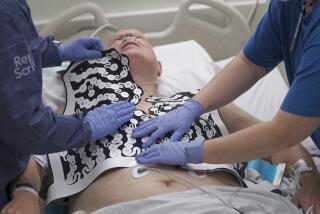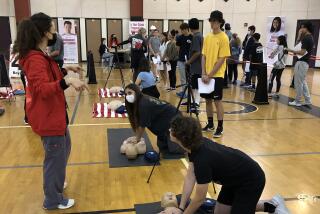Heart Study Gives Defibrillator Use a Big Jolt
- Share via
A miniature device that senses abnormal electrical activity in the heart and jolts it back into normal rhythms has the potential to save tens of thousands of lives each year among heart attack victims, researchers said Wednesday.
A major study of the implantable automatic defibrillators--like one given to Vice President Dick Cheney this summer--was terminated prematurely Tuesday because the devices reduced the death rate by 30%; researchers could no longer justify giving patients other, less effective treatments.
The normal beating of the heart is governed by tiny electrical impulses that control the heart muscle. When those impulses go awry--a malfunction known as ventricular fibrillation--the heart can suddenly stop beating. Such sudden cardiac death kills nearly 400,000 Americans each year, more than lung cancer, breast cancer and AIDS combined.
The defibrillators, which by giving a tiny shock to the heart can restart the normal electrical rhythm, already have been approved for the treatment of as many as 300,000 patients each year. The new results could double the number of people eligible to receive them.
Potentially, that could mean saving as many as 24,000 additional lives per year, said Dr. David Cannom of Good Samaritan Hospital in Los Angeles. The estimate is based on the study’s indication that for every 100 patients treated with the device, eight lives could be saved.
“This is incredibly exciting news,” said Dr. Kelly Tucker of the Orange County Heart Institute, one of the doctors participating in the study. “This is the most important clinical trial in cardiac medicine in the last two decades. It shows definitively that defibrillators can prolong lives in a huge group of Americans.”
The full potential of the devices would be realized only if doctors use them for all patients who could benefit. Although defibrillators have been recommended for many patients since 1996, fewer than 1 in 3 patients who are eligible actually receives them--in part because of the nearly $30,000 cost and in part because many physicians are not aware of their value.
The implantable device is a miniaturized version of the defibrillators commonly seen on television medical shows. Inserted into a small cavity in the chest and connected via thin leads to the heart, it constantly monitors heart rhythms. When abnormalities occur, the defibrillator administers a small shock to the heart to restore normal electrical patterns.
The immediate response prevents damage to the heart or other tissues. Often, patients don’t even know that their hearts have been shocked.
Since the implantable devices were first approved for use in 1996, doctors have restricted them to people whose hearts cannot pump more than 35% of the normal volume of blood and who have undergone tests that indicate their hearts are susceptible to sudden cardiac electrical problems.
That testing requires the patient to wear a heart monitor for at least a day so that any abnormal electrical activity can be detected, or to undergo an invasive electrophysiology test in which the heart’s electrical system is stressed to see if it will begin to defibrillate.
The goal of the new study was to simplify diagnosis of patients at high risk of sudden cardiac death, Cannom said. To be eligible for the trial, patients’ ejection fractions--the percentage of normal that their hearts were pumping--had to be 30% or less. But they were not required to undergo any electrical monitoring or testing.
Most of the patients had ejection fractions in the low 20s, Cannom said. “That’s a very sick group. Many were waiting for heart transplants.”
The trial enrolled more than 1,200 heart attack patients at 71 centers in the United States and five in Europe. Patients received either a defibrillator made by Guidant Corp. of Indianapolis or the best medical treatment. Three patients received a defibrillator for every two who received drugs.
Guidant, one of three manufacturers of implantable defibrillators, helped sponsor the study. The other manufacturers are Medtronic Inc. and St. Jude Medical Inc.
The patients in the study have been followed for an average of about 20 months. Although the data have not yet been completely analyzed, Cannom said, the death rate among patients receiving drugs was about 25%, while the rate among defibrillator patients was about 17%.
“This is the most compelling data around,” Cannom said. “If this doesn’t impress the medical community, it can’t be impressed.”
Physicians involved in the research will immediately begin implanting the devices in patients who haven’t already received them. At the Orange County Heart Institute, “we have eight patients still surviving in the medical treatment group,” Tucker said. “If we can get them rounded up, we will have them all in here next week to get defibrillators.”
In 1996, implantable defibrillators were approved by the Food and Drug Administration six days after an earlier trial proved their utility. The researchers in the current study hope that FDA approval for the new, larger class of patients will occur equally quickly.
In the meantime, the researchers are trying to get the word out to other cardiologists. When Cheney had his heart attack earlier this year, his cardiologists implanted a device called a stent designed to keep his reopened artery clear and told him he was fine, Tucker said. “I e-mailed him and told him that he was not fine, that he needed a defibrillator and that he should see an electrophysiologist.”
Whether because of Tucker’s advice or for other reasons, Cheney was subsequently tested and given an implantable defibrillator and has been fine ever since.
“If anybody would get an appropriate referral, it would be him,” Tucker said. But he didn’t, and Tucker and others are wondering how many other patients are also not being told of defibrillators.






